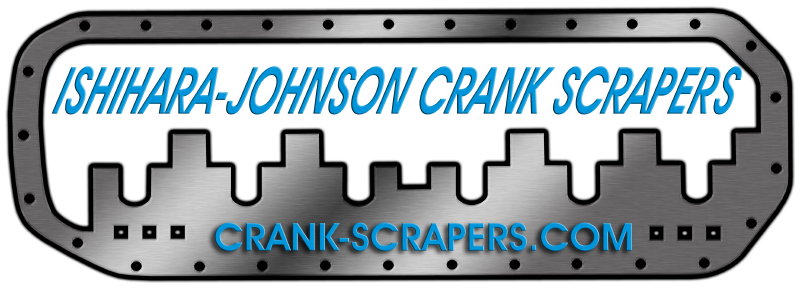|
General instructions for installing crank scrapers
and windage trays
.
.
Sometimes enthusiasts think that all parts from a manufacturer are identical. There are
NUMEROUS examples of this not being the case even with the same part number. This is a large topic.
.
.
Be sure to ask if there are particular areas to pay attention to with your engine.
Some scrapers install on the oil pan rail and some are mounted along main caps, for example.
.
.
If you are installing a Teflon bladed scraper there is a general instruction sheet.
There is also a general instruction sheet for using RTV type adhesives.
.
.
You must ALWAYS trial fit the scraper and/or windage tray and physically check that a
minimum of .040" or 1mm exists between any part and the rotating assembly. It is not
acceptable to go by sound or feel to determine clearances. You must use a feeler gauge
or visually confirm the clearance.
.
.
DO NOT USE THE STARTER MOTOR WHEN TRIAL FITTING
THE SCRAPER!
.
.
Drain the oil from the pan and remove pan from the engine block if the engine is still in the vehicle.
.
.
Remove the spark plugs. This will make rotating the engine during trial fitting
easier. Aside: Some engines should not be rotated backwards. You should determine from a
factory service manual whether your engine rotates clockwise or counterclockwise when
viewed from the front of the crankshaft. Also, some engines should only be rotated
using the crankshaft end-bolt rather than, for example, the timing belt cogs.
.
.
Check to see that the thrust clearance or end-play on the crank is within specs. If
this is not the case, you should install fresh thrust bearings. When fitting
the scraper as described below always remember to push the crank to both
extremes and check for proper clearance through full rotations of the engine.
.
.
Trial fit the scraper by picking mounting holes on either end of the block and
bolting it gently into place with several oil pan bolts. (Note: If you have a Teflon scraper,
treat the framework that holds the Teflon insert like a standard scraper at this point.
Remove the insert. You need to ensure that the steel frame and clamps also have at
least 1mm or .040” clearance as recommended for the standard steel scraper.)
.
.
There should not be any interference with the crank, rods, main bearing cap
bolts, or dip-stick but you may have to gently move the scraper under the
slightly loose mounting bolts to achieve this.
.
.
REPEAT: DO NOT USE THE STARTER MOTOR WHEN TRIAL
FITTING THE SCRAPER!
.
.
Slowly and gently rotate the crank through a full 360 degrees. While you are
doing this, carefully watch with a small light or feeler gauge to see that all the
rotating parts maintain at least a 1 mm (.040”) clearance with the scraper on all sides.
.
.
If, despite your careful shifting of the scraper, there are still parts that come
into contact or are too close then you will need to file or grind that area of the
scraper until the proper clearance is achieved. Remember to clean off any metal shavings.
.
.
You can mark this final position of the scraper relative to the block
with a scribe or marker. For absolutely positive relocation you may want to
drill a couple index holes through the scraper into the engine oil pan rail (not
the oil pan itself). Pick spots that are on opposite sides of the engine. Use a
short piece of thin metal rod (commonly available at local hardware stores) and
trim it so that when inserted it is flush with the surface of the installed scraper.
Drill the hole into the rail slightly smaller the outer diameter of the rod so that
it grabs it when you tap it in place. Drill the hole in the scraper slightly larger
than the rod so that the scraper can be removed.
.
.
If you have any questions please contact us.

|
